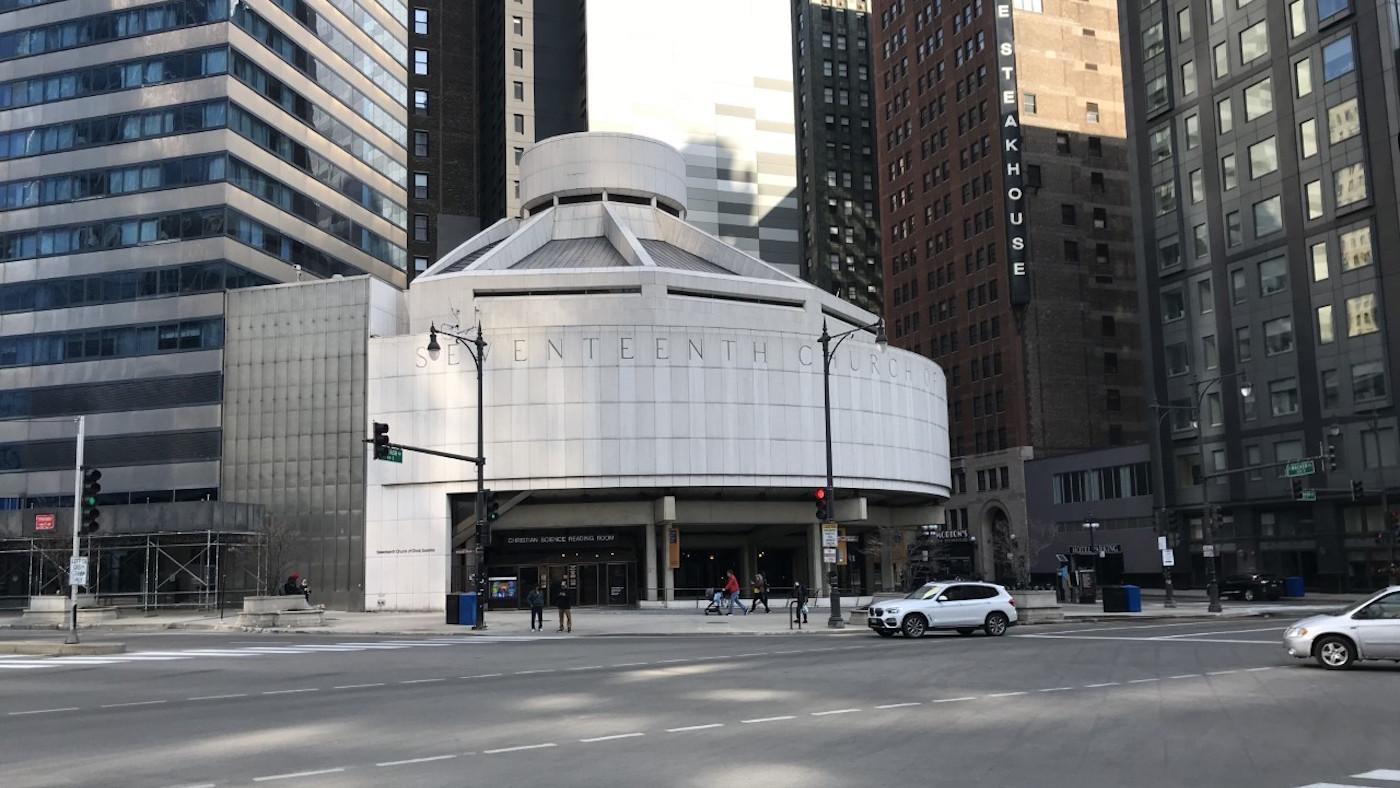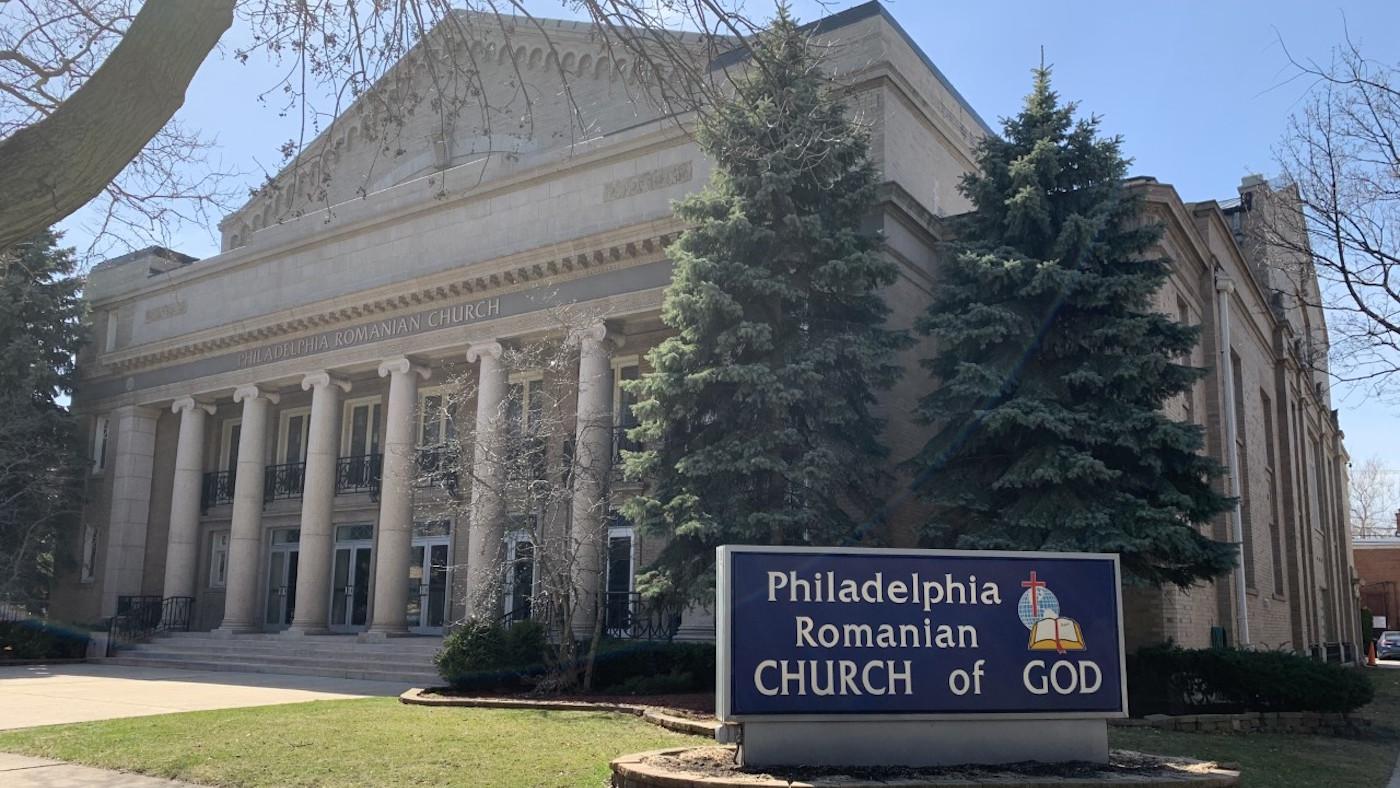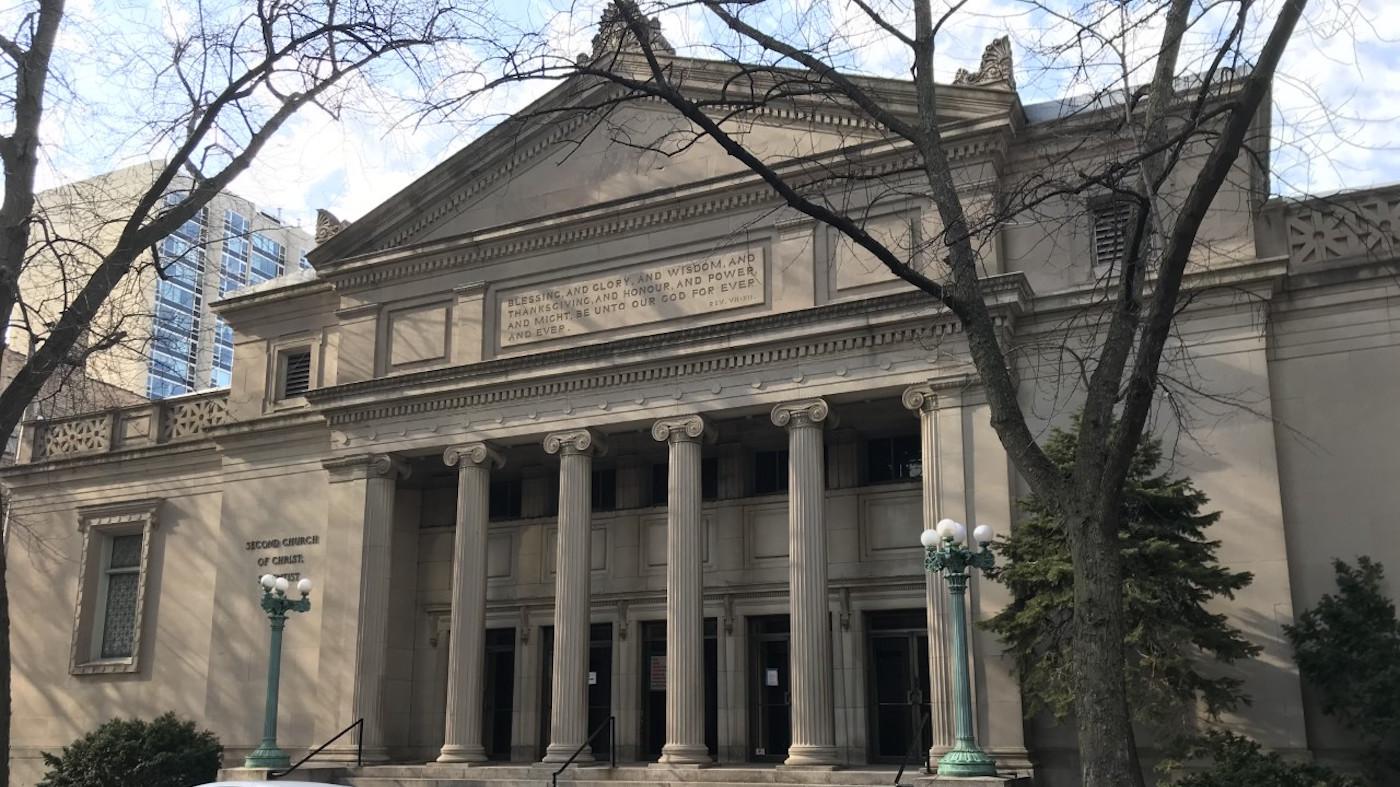The Varied Lives and Architecture of Chicago's Christian Science Churches
Daniel Hautzinger
May 11, 2021

As religious attendance declines and churches empty, developers have in recent decades bought and transformed holy edifices into dwellings. Such plans are always controversial, with critics accusing them of desecrating a sacred space and proponents arguing that they preserve a historical building while allowing it to be used for a new, contemporary purpose.
Two recent proposals to convert churches to condos have recently attracted spirited opposition. In December, City Council approved a plan to graft a multi-story apartment building onto the Second Church of Christ, Scientist, a plan that landed the church on Preservation Chicago’s list of seven most endangered buildings in 2019. (Roman Catholic churches also made the list that year and again in 2021.) A similar proposal to convert what was once the Fourteenth Church of Christ, Scientist in Ravenswood into an apartment building without preserving its worship space was rejected by the local alderman after objections from neighbors; a new proposal is supposedly in the works.
Both buildings have colonnaded fronts and domed roofs, grand touches for their locations on quiet residential streets. What is a “Church of Christ, Scientist,” and how many of them are there in Chicago?
You would almost certainly recognize one of them. The Seventeenth Church of Christ, Scientist sits proudly along the river at Wabash Avenue and Wacker Drive downtown. Its clean-lined edifice, designed by Harry Weese in 1968, has been seen in films such as Divergent and Transformers 3. The building is one of only a few original Churches of Christ, Scientist in Chicago that still houses a Christian Science congregation.
 A plan to develop what was once the Fourteenth Church of Christ, Scientist in Ravenswood into apartments is being re-evaluated. Photo: Caitrin Hughes
A plan to develop what was once the Fourteenth Church of Christ, Scientist in Ravenswood into apartments is being re-evaluated. Photo: Caitrin Hughes
Founded in the nineteenth century by Mary Baker Eddy, Christian Science is a branch of Christianity that is non-hierarchical and emphasizes the importance of prayer and individual testimony. “Christian Science is mainly known for its commitment to the healing of disease and sin through prayer, as taught by Jesus,” writes Tim Mitchinson, the spokesman for Christian Science in Illinois, in an email—although he emphasizes that “Church members can make their own health care decisions.”
“Maybe the most important thing to know is that the Christian Science church is maintained by individuals who strive to live the love Christ Jesus lived,” Mitchinson says. “They establish and serve their churches because they love God, and they love their fellow man.”
People have been adapting Christian Science churches to new purposes for decades. Over three decades at the beginning of the nineteenth century, Christian Scientists built seventeen stately churches in Chicago; today, fourteen of those edifices survive, but only one still houses a Christian Science congregation. (There are still five congregations in Chicago, although two have moved to more modest buildings and one shares a church with another denomination. The suburbs host twenty more congregations.)
Some Christian Science edifices are being developed into condos or townhouses, like the Fifth Church of Christ, Scientist in Kenwood, while many now serve as worship spaces for other denominations—mostly Christian, although Skokie’s Christian Science church is now a synagogue. A Prairie-style former Christian Science church in Riverside is now a private residence, and Evanston’s First Church of Christ, Scientist houses the Music Institute of Chicago’s Nichols Concert Hall.
As Christian Science grew in Chicago after first gaining broad exposure at the World’s Parliament of Religions at the 1893 World’s Columbian Exposition, congregations began building churches around the city, tracking in some ways Chicago’s own explosive growth. The first three constructed marked each side of the city: in what is now Bronzeville in 1897, in Lincoln Park in 1901 (the Second Church whose plan for redevelopment is under contention), and near what is now the United Center in 1901.
Both the First and Second Churches were designed by Solon Beman, who had designed the town of Pullman and later worked on an extension to the Christian Science Mother Church in Boston after converting to Christian Science. He and his son Spencer designed some 90 Christian Science churches between them.
It was Solon Beman who codified the Classic Revival style as the most common architectural style for Christian Science churches in the first few decades of the twentieth century, its ascendant period: columned porticos, domed halls, subdued ornamentation. As he wrote in an essay, the style’s “sense of calm proportion, its sincerity and refinement, and…its rationalism…represent the faith of those who employ it in their house of worship.”
 City Council recently approved a plan to graft a multi-story apartment tower onto the Second Church of Christ, Scientist in Lincoln Park. Photo: Daniel Hautzinger
City Council recently approved a plan to graft a multi-story apartment tower onto the Second Church of Christ, Scientist in Lincoln Park. Photo: Daniel Hautzinger
As Elizabeth Hoffman Ransford notes in a dissertation on sacred space in Chicago, “Through spatial markers, religious groups announce their identities and contrast them to competing religious identities.” Rational Classical Revival architecture was thus useful to Christian Scientists defining themselves against the “mysticism of traditional Christianity and the Gothic architecture that symbolized this mystical element.”
But not all Christian Science churches were built in this style, especially as the twentieth century progressed. Even the Gothic style was occasionally used. As Mitchinson explains, “Each church is democratically run by the individual members, so you can imagine the discussions that take place as a congregation decides what architectural style their church should be!”
Charles Draper Faulkner, who designed numerous Christian Science churches including South Shore’s Romanesque Eighteenth Church and the interior of Austin’s Fifteenth Church, wrote in his 1946 Christian Science Church Edifices that there was “no such thing” as a Christian Science style of architecture, although, like Beman, he sets forth a preference for proportion and harmony over excessive ornamentation. By the time he wrote his book, Faulkner had decided that the Colonial style was most appropriate, given its simplicity, cost-effectiveness, and American roots that matched Christian Science’s own indigenous origins.
While Colonial-style Christian Science churches were built in other parts of the country, Chicago’s early churches mostly adhered to Beman’s Classical Revival template, which followed the influential architecture of the Columbian Exposition and fit in with the rationalizing City Beautiful movement of the Exposition’s Director of Works, Daniel Burnham. Columned porticos and domes sprouted in generally wealthy neighborhoods throughout the city from around 1900 to 1926—Christian Scientists tended to be wealthy and well-educated, thus holding “disproportionate cultural influence to the number of its members, which never rose [above] about more than a quarter million,” according to Ransford.
 The Fifth Church of Christ, Scientist in Kenwood is being developed into "13 Three Story Luxurious Townhomes." Photo: Daniel Hautzinger
The Fifth Church of Christ, Scientist in Kenwood is being developed into "13 Three Story Luxurious Townhomes." Photo: Daniel Hautzinger
Weese’s church (and Walter Kroeber’s Skokie church) diverge so radically from the Classical Revival style because they were built much later, in the 1960s. Although the Seventeenth Church congregation was established downtown in 1924, the same year the Sixteenth Church in Rogers Park constructed its first church building, it didn’t decide to build itself a church until the late 1940s. In 1955, it purchased the property at Wabash and Wacker, then not the prime real estate it is now. Frank Lloyd Wright among others was considered as architect before Weese was chosen. While the façade is definitely modern, it still reflects the same values that Beman and Faulkner thought a Christian Science church should demonstrate.
By the time the Seventeenth Church was finished in 1968, Christian Science was in decline. Although membership numbers are not published, a WBEZ story cites a scholar who contends that the number of Christian Scientists began to fall in the 1940s. The decline is evident in the sale of many of the early Christian Science churches, although the Second and Seventeenth in Chicago still hold on in their original homes.
In the case of the Second Church, residential homes may soon tower directly above that spiritual home. There’s perhaps no better visual metaphor of the decline of religion in America than the transformation of a sacred space into a commodified secular one.







